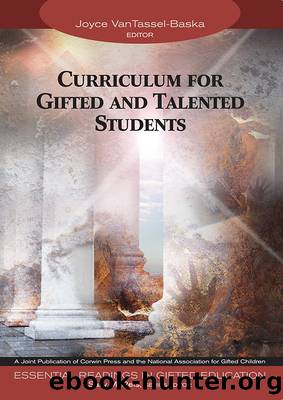Curriculum for Gifted and Talented Students by VanTassel-Baska Joyce;Reis Sally M.;

Author:VanTassel-Baska, Joyce;Reis, Sally M.; [VanTassel-Baska, Joyce]
Language: eng
Format: epub
ISBN: 1994279
Publisher: Corwin Press
Published: 2003-11-06T00:00:00+00:00
Interestingness of tasks and task commitment are interdependent constructs. One of the most frequently asked questions about my own work in connection with the three-ring conception of giftedness (Renzulli, 1978a, 1986) is: Where does task commitment come from? Although the answer to this question is undoubtedly a complex one, a major contribution to what may be called the energizing function is unquestionably the interaction between the amount of energy that is part of the individualâs personality and physical make-up on one hand, and the interestingness of the task or object on the other. This relationship is represented in Figure 3.
Not all tasks and objects within a given domain are created equal so far as interestingness is concerned, and unfortunately there has been very little if any research that deals directly with ways of evaluating interestingness. Amabile (1989) reviewed several studies dealing with the ways in which work environments influence creativity, and Ward (1969) found that children who pursue creativity tasks in an environmentally rich room show higher levels of ideational fluency than children who performed in a bare room. Feldhusen, Hobson, and Treffinger (1975) found that subjects engaged in a divergent thinking task produced more original responses when provided with verbal stimuli associated with remote responses. If we are to capitalize on what we know about the crucial roles played by interest and task commitment in creative productivity, this type of research, which examines factors outside the individual, might help us to identify those topics that have the highest degrees of interestingness. This research might begin by recruiting persons with experience in a domain to identify those aspects of a topic that hold the greatest potential for stimulating interest and excitement on the parts of students. Although investigations of the energizing function will certainly add to our understanding of interest development and task commitment, this function is undoubtedly buried deep within the physical and psychological make-up of the individual. It is for this reason that a careful analysis of interestingness of tasks or objects is recommended as a potentially valuable area of inquiry within this general model.
Learning Styles
Several investigators have suggested that an area of major importance in which students differ is their style of learning. Learning styles have been variously defined according to psychological types such as introversion versus extroversion (Myers, 1980) and preference for varying degrees of structure in the learning process (Hunt, 1975). Kolb, Rubin, and McIntyre (1971) and Gregorc (1985) have proposed that styles vary according to preferences that can be plotted on axes ranging from concrete to abstract and from sequential to random. Dunn, Dunn, and Price (1975) proposed a definition and instrument based on student preferences for various physical characteristics of the learning environment (e.g., auditory and mobility preferences, comfort requirements, and preference for individual versus group work), and Barbe and Swassing (1979) have examined learning styles in terms of sensory modality preference (visual, auditory, tactile, and kinesthetic). Renzulli and Smith (1978) developed an instrument that assesses styles in correspondence with the following instructional
Download
This site does not store any files on its server. We only index and link to content provided by other sites. Please contact the content providers to delete copyright contents if any and email us, we'll remove relevant links or contents immediately.
| Behavioral Disorders | Communicative Disorders |
| Gifted Students | Inclusive Education |
| Learning Disabled | Mentally Disabled |
| Physically Disabled |
The Art of Coaching Workbook by Elena Aguilar(51000)
Trainspotting by Irvine Welsh(21521)
Twilight of the Idols With the Antichrist and Ecce Homo by Friedrich Nietzsche(18510)
Fangirl by Rainbow Rowell(9104)
Periodization Training for Sports by Tudor Bompa(8173)
Change Your Questions, Change Your Life by Marilee Adams(7639)
This Is How You Lose Her by Junot Diaz(6800)
Asking the Right Questions: A Guide to Critical Thinking by M. Neil Browne & Stuart M. Keeley(5653)
Grit by Angela Duckworth(5525)
Red Sparrow by Jason Matthews(5392)
Paper Towns by Green John(5092)
Room 212 by Kate Stewart(5041)
Ken Follett - World without end by Ken Follett(4647)
Housekeeping by Marilynne Robinson(4349)
The Sports Rules Book by Human Kinetics(4299)
Double Down (Diary of a Wimpy Kid Book 11) by Jeff Kinney(4209)
Papillon (English) by Henri Charrière(4199)
The Motorcycle Diaries by Ernesto Che Guevara(4018)
Exercise Technique Manual for Resistance Training by National Strength & Conditioning Association(3960)
